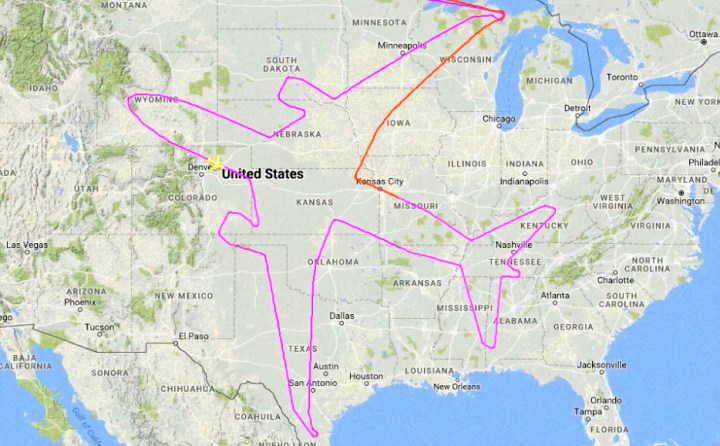
The pilot of the Boeing 787 aircraft spent a whole 18 hours drawing an outline of the plane — better known as the Dreamliner — that covered more than 20 states from Michigan in the north to Texas in the south. Let’s be clear about this — he wasn’t in the cockpit with a huge piece of paper and a pack of crayons; he was flying the plane in the shape of a plane.
The image could be seen gradually forming on online flight tracker services like Flightradar24 and FlightAware.
Rather than a costly publicity stunt aimed at highlighting the ability of the Dreamliner to fly for almost a day without needing to refuel, the exercise was in fact a necessary endurance test for a Rolls-Royce aircraft engine that’s currently undergoing certification.
Boeing’s aircraft took off from Seattle on Wednesday afternoon, flying around 2,000 miles to northern Michigan to begin its aerial artwork, starting at the plane’s wing tip.
“Rather than fly in random patterns, the test team got creative, flying a route that outlined a 787-8 in the skies over 22 states,” Boeing said at the end of its mammoth journey. “The nose of the Dreamliner is pointing at the Puget Sound region, home to Boeing Commercial Airplanes. The wings stretch from northern Michigan near the Canadian border to southern Texas. The tail touches Huntsville, Alabama.”
Time FLIES when you’re having fun #avgeek [Total flight time: 18 hrs, 1 min] https://t.co/151oNsMFOY pic.twitter.com/ThNWC5IM5k
— Boeing Airplanes (@BoeingAirplanes) August 3, 2017
Flightradar24 appeared to have had advance notice of the special flight, telling plane watchers shortly after the aircraft took off to “keep an eye on this one.”
At the end of the trip, the online flight tracker tweeted that “you might as well have a bit of fun” if you have to go on such a long test flight.
But not everyone was impressed by the artistic efforts of Boeing’s pilots, with one person asking the company if it was “fun wasting fuel and pouring tons of CO2 in the atmosphere.” Boeing responded by saying the flight had been a necessary exercise in order to test the engine.
It’s not the first time the plane manufacturer has taken a somewhat circuitous route to put one of its planes through its paces. Earlier this year it flew a Boeing 737 MAX aircraft over Washington state and nearby Montana, writing out “MAX” in the process.


